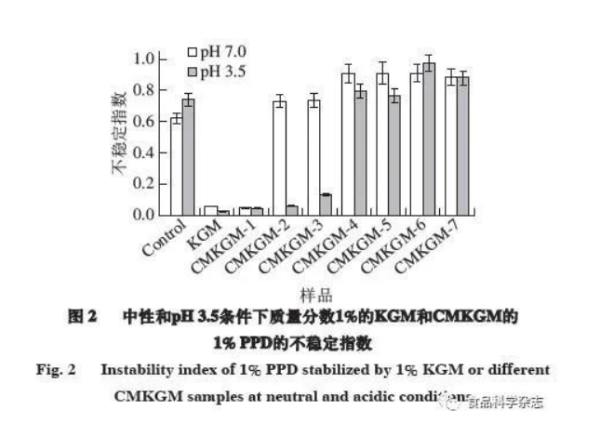Compared with the long-existing animal protein (mainly casein) beverages in the market, consumers’ demand for neutral and acidic vegetable protein beverages has been increasing in recent years. As a natural sustainable protein of plant origin, pea protein is one of the reliable raw materials for replacing animal protein in food formulations, and undoubtedly has a stronger application prospect in the protein beverage industry. However, pea protein has low solubility in water and poor physical stability due to its strong surface hydrophobicity and low charge. Especially under acidic conditions, the application of pea protein in acidic protein drinks is greatly limited. How to control the stable dispersion of pea protein under neutral, especially acidic conditions, is the main bottleneck for the development of pea protein beverages.
In the field of emulsion product research, the need for high-performance stabilizers and the elucidation of different stabilization mechanisms of stabilizers are constantly evolving. A recent study comparing the ability of konjac glucomannan (KGM), CMC and corn fiber gum and carboxymethyl-modified corn fiber gum (CMCFG) to improve the stability of pea protein dispersion (PPD) found that the addition of KGM can The physical stabilization of PPD under neutral and acidic (pH 3.5) conditions was achieved through viscosity enhancement, while the carboxymethylated CMC and CMCFG contributed to the stabilization of the system through electrostatic adsorption with pea protein.
Studies have shown that carboxymethyl konjac glucomannan (CMKGM) can greatly improve its water solubility and aqueous solution stability on the basis of maintaining the original biocompatibility and thickening properties of KGM. Based on the synthesis of a series of CMKGMs with different degrees of substitution and different molecular masses, Tao Ran, Li Ruiqi, Zhang Hongbin* and others from the School of Chemistry and Chemical Engineering, Shanghai Jiao Tong University, through the analysis of system particle size, Zeta potential, apparent viscosity and instability index. Determination, focusing on the effect of CMKGM on the stabilization behavior of PPD under the condition of simultaneous changes in molecular mass and degree of substitution, evaluating its stabilization effect on PPD under neutral and acidic conditions, and analyzing its different stabilization mechanisms, with a view to developing new milk beverages Stabilizer, providing valuable technical information for the development of vegetable protein-based beverage formulations.
1. Comparison of stabilization effects of different CMKGMs on PPD systems under certain conditions of mass fraction

As shown in Figure 1 (click below to read the original text to view Figure 1), on the transmission curve, the red line represents the transmittance of the sample in the initial state, and the green line represents the transmittance of the sample during the test. During centrifugation, the dense dispersed phase gradually migrates to the bottom of the sample tube, thereby increasing the permeability of the supernatant fraction. The stability of the dispersion can be reflected by the change of the transmission curve. In general, the greater the change in transmittance during centrifugation, the less stable the sample will be. The instability index of the sample can also be obtained based on the transmission curve, which can quantitatively characterize the stability of different samples (Figure 2). The value of the instability index is between 0 and 1, where 0 means the system is very stable and 1 means the system is very unstable. In the stability evaluation, the instability index is 0.2 or below as the stability standard.
2. The critical addition amount of CMKGM with different molecular parameters to stabilize the PPD system
The lower the molecular weight of CMKGM, the higher the critical polysaccharide addition required for stabilization. From 1% of CMKGM-1 to 20% of CMKGM-7 to stabilize PPD. It can be seen that although the degree of substitution is high, the molecular mass is the dominant factor for CMKGM to stabilize PPD. Too low molecular weight not only weakens the viscosity-increasing effect of the continuous phase of the PPD system, but also fails to form an effective steric hindrance on the surface of the protein particles after adsorption. It should be pointed out that for the three samples of CMKGM-1, CMKGM-2 and CMKGM-3, the mass fraction of polysaccharides required to achieve the physical stability of the system (instability index less than 0.2) is all below 2%, which is more useful from the perspective of practical application. economical. Moreover, compared with unmodified KGM, the water solubility of modified CMKGM increases and the molecular weight decreases, which is expected to improve the bad taste caused by the high viscosity of KGM.
In conclusion
With the increase of the degree of substitution, the mass fraction of CMKGM required to achieve the stability of the PPD system gradually increased when the molecular mass gradually decreased, and the molecular mass of CMKGM had a greater impact on the stability of the system than the degree of substitution. Among the prepared 7 modified samples (CMKGM-1~CMKGM-7, the molecular mass decreases in turn and the substitution degree increases in turn), CMKGM-1, CMKGM-2 and CMKGM-3 with low molecular weight and low substitution degree are in When the mass fraction is less than 2%, both neutral and acidic PPD systems can achieve good physical stability, while CMKGM with low molecular weight and high degree of substitution can stabilize the PPD system under the condition of higher mass fraction. Electrostatic repulsion, steric hindrance effect and high viscosity of continuous phase are the main factors for CMKGM to improve the stability of PPD. Under neutral conditions, since CMKGM does not adsorb, its viscosity-enhancing effect on the continuous phase is the dominant factor for the stability of the system, while under acidic conditions, the viscosity-enhancing effect of CMKGM on the continuous phase and the formation of electrostatic complexes between CMKGM and pea protein The generated electrostatic repulsion and steric hindrance together promote the stability of the system.
